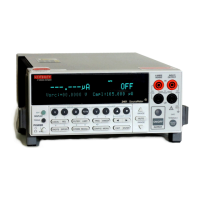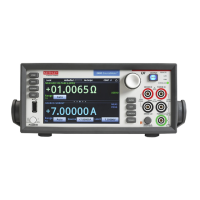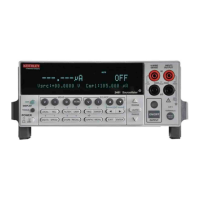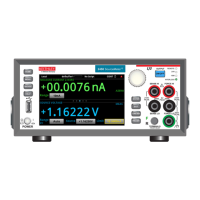2400 Series SourceMeter
®
User’s Manual Data Store 9-5
Timestamp accuracy
Because of internal timing methods, the timestamp value is only approximate. The method
in which the timestamp is implemented limits its use in time-critical applications. If accu-
rate test timing is crucial, it is recommended that an external timer be used in conjunction
with the SourceMeter.
The timestamp is based on an oscillator with a frequency of approximately 8kHz. This
oscillator is used as the system clock and is divided by eight to generate system “ticks”
every millisecond. Therefore, the timestamp should provide lms resolution for test timing.
However, since the actual oscillator frequency is 8.192kHz, a system tick occurs every
8.192kHz/8 or 1,024 times a second, which results in a system tick every 0.9765625ms. In
firmware revision C17 and before, the reported timestamp value is off by 24ms every sec-
ond. Thus, to obtain more accurate timestamp values, simply multiply the timestamp dis-
played on the front panel or returned via remote by a factor of 0.9765625. This correction
should not be necessary if the unit firmware revision is C18 or higher, as the timestamp
correction has already been made internally.
Buffer considerations
From the front panel, 2500 source-measure readings can be stored and accessed using the
method described earlier in this section. Over the bus, however, there are actually two sep-
arate 2500 reading buffers for a total of 5000 readings. The :TRACe buffer is a 2500 read-
ing buffer used by front panel data store, bus :TRACe commands, and to store sweep data,
and it is battery backed-up. The READ? buffer is a separate 2500 reading buffer that can
only be accessed over the bus using the :READ? command. You can store and access data
from these two buffers separately as outlined below.
Using :TRACe commands to store data
Use :TRAC:POIN <n> and :TRIG:COUN <n> followed by :TRAC:FEED:CONT NEXT
to store data. (n = number of readings; 2500 maximum.) Turn on the output with :OUTP
ON and then send :INIT to take the unit out of idle and store readings. After data is stored,
send :TRAC:DATA? to access it. See Table 9-1 in this section for a summary of these
commands and Section 18, “TRACe subsystem,” for more details.
Using :READ? to store data
Use :TRIG:COUN <n> to set the number of readings to be stored. (n = number of read-
ings; 2500 maximum.) Turn on the output with :OUTP ON and then send the :READ?
command to trigger and access readings. (Once you access these readings, you will still be
able to access previously stored :TRACe buffer readings using :TRAC:DATA?.) See
Section 11 and Section 18, “TRIGger subsystem,” for triggering details, and Section 17
for information on the :READ? command.
Artisan Technology Group - Quality Instrumentation ... Guaranteed | (888) 88-SOURCE | www.artisantg.com

